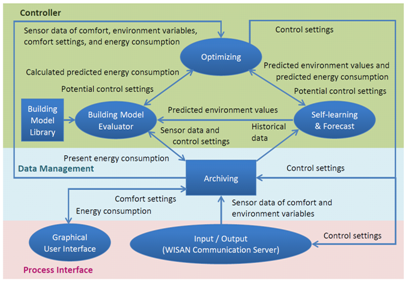Self-Learning Energy Efficient builDings and open Spaces (SEEDS) is a Research project co-funded by the European Commission under the Seventh Framework Program (Call FP7-2011-NMP-ENV-ENERGY-ICT-EeB). It started in September 2011 and its final tasks are scheduled for February 2015.

CIDAUT is one of the nine European partners in this project, coordinated by CEMOSA, which is focused on saving energy in the building sector through the development of specific optimization and self-learning methodologies, supported by new ICT and wireless technologies.
The SEEDS project has developed new technologies for optimizing building’s performance in terms of energy, comfort and life cycle costs. SEEDS applies an innovative building modelling methodology based on measurements and self-learning techniques. Modern optimization algorithms allows SEEDS to minimize energy consumption while keeping comfort and health conditions. A network of wireless sensors and actuators suitable for Building Automation Systems has been developed under SEEDS to facilitate its deployment and application to retrofitting of old buildings.SEEDS is an Energy Management System suitable not only for buildings but also for the surrounding open spaces. Its open architecture may be applied either in retrofitting of old buildings but also in new building designs.
It is based on research and scientific advances in wireless sensor technology, machine learning, and Bayesian networks, as well as standard statistical methods to enable the relationships between key variables to be continuously learned, facilitate prediction and enable control.
The technology is being tested in two very different validation pilots: an office building in Madrid (Hot Southern Europe) and a University building in Stavanger (Cold Northern Europe).
The core of the project has already been developed, including:
- Development of a modelling methodology for a wide spectrum of building types and energy systems and subsystems.
- Research and development of scalable implementations of global optimization algorithms.
- Development of self learning and optimization behavioural models for energy systems and subsystems in buildings.
- Development and adaptation of a network of Wireless Intelligent Sensors and Actuators (WISA) and design and implementation of communication middleware and configuration tools for the WISA.
- Development and refinement of anytime self-learning and optimization algorithms able to cope with the requirements of energy management systems.
- Definition of the RoadMap for the implementation and commissioning of SEEDS into the two validation pilots.
- Analysis of the energy facilities and performance of the two demo pilots, selection of sensors to evaluate the initial condition of the two demo pilots.
- Selection of the equipment to be monitored and controlled in both demo pilots, selection of sensors and actuators and design of wireless communication elements (nodes and gateways).
- Development of a MS Access database describing all relations between rooms, devices, sensors, actuators, signals, variables, comfort boundaries and energy consumption.
- Definition of control settings for a proper operation of building devices.
- Installation of wireless communication elements and the corresponding connections to sensors and actuators.
- Definition of a self-learning training procedure and adequate local control algorithms to run the equipment in the first few days of operation.
- Generation of a Graphical User Interface so as to the system is able to communicate with the operator.
- Development of the necessary software programs to connect all the elements and run the whole system.
- Definition and execution of system test plans.
Developments over the next six months will include:
- Run the system in both demonstrators, verifying the correct operation of algorithms and communication elements.
- Assessment of energy efficiency and energy savings achieved, by comparing the current energy consumption with the one measured before the implantation of the new system.
- Life cycle impact assessment of this new BEM (Building Energy Management) system.
- Post-occupancy study, based on a user survey.
- Development of a guide for “Best practices for energy efficient buildings and open spaces”.
At the end of this project we expect to have demonstrated the technical feasibility and verify the energy efficiency of a new control system for buildings applying optimization and self-learning algorithms based on the measured data. Wireless communication signals make it suitable to building retrofitting.
